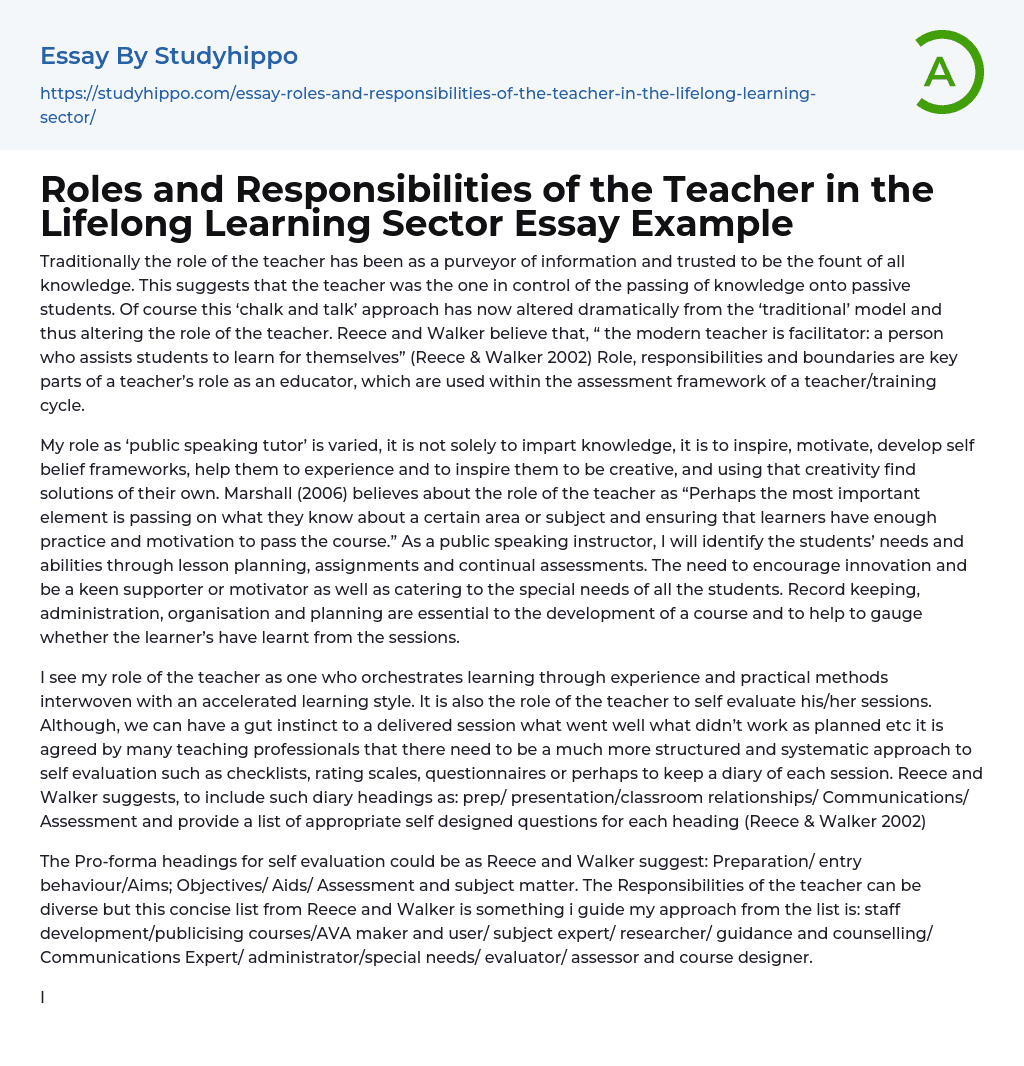

Roles and Responsibilities of the Teacher in the Lifelong Learning Sector Essay Example
Traditionally the role of the teacher has been as a purveyor of information and trusted to be the fount of all knowledge. This suggests that the teacher was the one in control of the passing of knowledge onto passive students. Of course this ‘chalk and talk’ approach has now altered dramatically from the ‘traditional’ model and thus altering the role of the teacher. Reece and Walker believe that, “ the modern teacher is facilitator: a person who assists students to learn for themselves” (Reece & Walker 2002) Role, responsibilities and boundaries are key parts of a teacher’s role as an educator, which are used within the assessment framework of a teacher/training cycle.
My role as ‘public speaking tutor’ is varied, it is not solely to impart knowledge, it is to inspire, motivate, develop self belief frameworks, help them to
...experience and to inspire them to be creative, and using that creativity find solutions of their own. Marshall (2006) believes about the role of the teacher as “Perhaps the most important element is passing on what they know about a certain area or subject and ensuring that learners have enough practice and motivation to pass the course.” As a public speaking instructor, I will identify the students’ needs and abilities through lesson planning, assignments and continual assessments. The need to encourage innovation and be a keen supporter or motivator as well as catering to the special needs of all the students. Record keeping, administration, organisation and planning are essential to the development of a course and to help to gauge whether the learner’s have learnt from the sessions.
I see my role of the teacher as one who orchestrate
learning through experience and practical methods interwoven with an accelerated learning style. It is also the role of the teacher to self evaluate his/her sessions. Although, we can have a gut instinct to a delivered session what went well what didn’t work as planned etc it is agreed by many teaching professionals that there need to be a much more structured and systematic approach to self evaluation such as checklists, rating scales, questionnaires or perhaps to keep a diary of each session. Reece and Walker suggests, to include such diary headings as: prep/ presentation/classroom relationships/ Communications/ Assessment and provide a list of appropriate self designed questions for each heading (Reece & Walker 2002)
The Pro-forma headings for self evaluation could be as Reece and Walker suggest: Preparation/ entry behaviour/Aims; Objectives/ Aids/ Assessment and subject matter. The Responsibilities of the teacher can be diverse but this concise list from Reece and Walker is something i guide my approach from the list is: staff development/publicising courses/AVA maker and user/ subject expert/ researcher/ guidance and counselling/ Communications Expert/ administrator/special needs/ evaluator/ assessor and course designer.
It is crucial nowadays that every teacher is aware of current legislation (Every Child / person matters) that affects learners and their ability to contribute in a safe environment. There fore it is the responsibility of the teacher to endorse: the equal opportunities/ child protection/ data protection and of course health and safety. The teacher has a responsibility to prepare for lessons, make sure they are meaningful and have clear aims and objectives for each session. It is crucial to be a good communicator and to encourage debate within the classroom that leads to deeper understanding
of the area of public speaking.
Kelley-Browne, (2007) p18, states “One of the core professional values expected of teachers in the school context is that of demonstrating awareness and consideration for the social, cultural, linguistic, religious and ethnic backgrounds of the pupils they teach.” Every student should be treated equally through equal opportunities and ensuring the health and safety of the group. When a new tutor accepts a new post or position it is imperative that she /he adheres to the code of practice set out by that organisation. These boundaries are there to protect the student as well as the teacher. What would be outlined is as Gravells (2008) insists as “...knowing where your role as a tutor stops”. A tutor has to set an example, by dressing appropriately and being polite. Never bully or allow bulling by enforcing the ground rules. It is vital to not to date students, to keep personal life private, and political views out the classroom. A tutor/teacher must place professional, physical and mental distance between themselves and the students, whilst still being friendly.
- Interpretation essays
- Plagiarism essays
- Analogy essays
- Learning English essays
- Coaching essays
- Critical Thinking essays
- homework essays
- Learning essays
- Library essays
- Listening essays
- Literacy essays
- Mentor essays
- Physical Education essays
- Project essays
- Reading essays
- Research essays
- Sex Education essays
- Social Studies essays
- Standardized Testing essays
- Study Plan essays
- Teaching essays
- Classroom essays
- College essays
- E-Learning essays
- Elementary School essays
- Examination essays
- Graduate School essays
- High School essays
- History Of Education essays
- Homeschooling essays
- Kindergarten essays
- Middle School essays
- Public School essays
- School essays
- Single Sex Schools essays
- Special Education essays
- Student essays
- Teacher essays
- University essays
- Vocational Education essays



